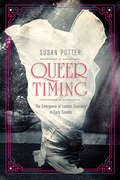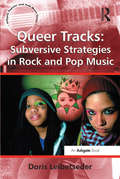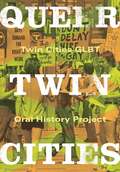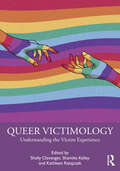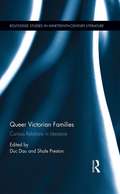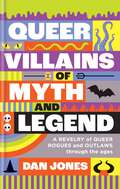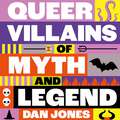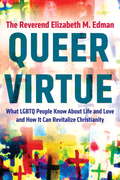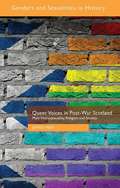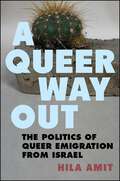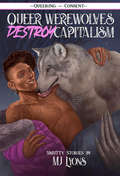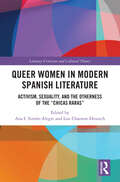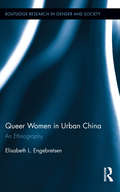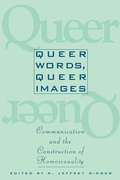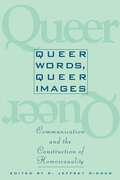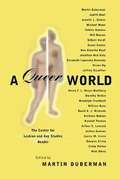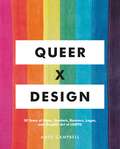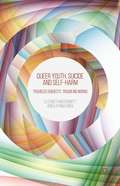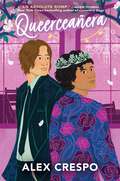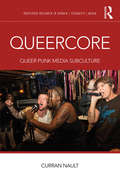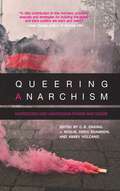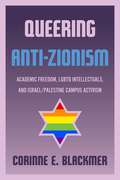- Table View
- List View
Queer Timing: The Emergence of Lesbian Sexuality in Early Cinema (Women & Film History International)
by Susan PotterIn Queer Timing, Susan Potter offers a counter-history that reorients accepted views of lesbian representation and spectatorship in early cinema. Potter sees the emergence of lesbian figures as only the most visible but belated outcome of multiple sexuality effects. Early cinema reconfigured older erotic modalities, articulated new--though incoherent--sexual categories, and generated novel forms of queer feeling and affiliation. Potter draws on queer theory, silent film historiography, feminist film analysis, and archival research to provide an original and innovative analysis. Taking a conceptually oriented approach, she articulates the processes of filmic representation and spectatorship that reshaped, marginalized, or suppressed women's same-sex desires and identities. As she pursues a sense of "timing," Potter stages scenes of the erotic and intellectual encounters shared by historical spectators, on-screen figures, and present day scholars. The result is a daring revision of feminist and queer perspectives that foregrounds the centrality of women's same-sex desire to cinematic discourses of both homo- and heterosexuality.
Queer Tracks: Subversive Strategies In Rock And Pop Music (Ashgate Popular and Folk Music Series)
by Doris LeibetsederQueer Tracks describes motifs in popular music that deviate from heterosexual orientation, the binary gender system and fixed identities. This exciting cutting-edge work deals with the key concepts of current gender politics and queer theory in rock and pop music, including irony, parody, camp, mask/masquerade, mimesis/mimicry, cyborg, transsexuality, and dildo. Based on a constructivist concept of gender, Leibetseder asks: ’Which queer-feminist strategies are used in rock and pop music?’ ’How do they function?’ ’Where do they occur?’ Leibetseder's methodological process is to discover subversive strategies in queer theory, which are also used in rock and pop music, without assuming that these tactics were first invented in theory. Furthermore, this book explains where exactly the subversiveness is situated in those strategies and in popular music. With the help of a new kind of knowledge transfer the author combines sociological and cultural theories with practical examples of rock and pop music. The subversive character of these queer motifs is shown in the work of contemporary popular musicians and is at the same time related to classical discourses of the humanities. Queer Tracks is a revised translation of Queere Tracks. Subversive Strategien in Rock- und Popmusik, originally published in German.
Queer Twin Cities
by Kevin P. Murphy Jason Ruiz Twin Cities GLBT Oral History Project Staff Alex T. Urquhart Jennifer L. Pierce Larry Knopp Charlotte Albrecht Pamela Butler Brandon Lacy Cmapos Susan Craddock Michael Franklin Patrick RyanThe Twin Cities is home to one of the largest and most vital GLBT populations in the nation-and one of the highest percentages of gay residents in the country. Drawn from the pioneering work of the Twin Cities GLBT Oral History Project-a collective organization of students, scholars, and activists devoted to documenting and interpreting the lives of GLBT people in Minneapolis and St. Paul-Queer Twin Citiesis a uniquely critical collection of essays on Minnesota's vibrant queer communities, past and present. A rich blend of oral history, archival research, and ethnography,Queer Twin Cities uses sexuality to chart connections between people's lives in Minnesota. Topics range from turn-of-the-century Minneapolis amid moral reform-including the highly publicized William Williams murder trial and efforts to police Bridge Square, aka "skid row"-to northern Minnesota and the importance of male companionship among lumber workers, and to postwar life, when the increased visibility of queer life went hand in hand with increased regulation, repression, and violence. Other essays present a portrait of early queer spaces in the Twin Cities, such as Kirmser's Bar, the Viking Room, and the Persian Palms, and the proliferation of establishments like the Dugout and the 19 Bar. Exploring the activism of GLBT/Two-Spirit indigenous people, the antipornography movements of the 1980s, and the role of gay men in the gentrification of Minneapolis neighborhoods.
Queer Victimology: Understanding the Victim Experience
by Shelly Clevenger Shamika Kelley Kathleen RatajczakThis book provides a much-needed focus on the victimization experiences of those within the lesbian, gay, bisexual, transgender, Queer, intersex, or asexual (LGBTQIA) communities. With original research and scholarly work relating to victimization, supplemented by stories and poems detailing firsthand accounts by people in LGBTQIA communities, the volume editors shine a light on the experiences of those who have been harmed or who have suffered because of who they are. Allowing the reader to gain a deeper understanding of Queer victimization and LGBTQIA victims, the volume delves into how and why people are victimized, as well as how the criminal justice system and other social services interact with victims and each other. The creative pieces included give a direct voice to those who have most often been silenced in the past. Queer Victimology is essential reading for scholars and students in the areas of criminology, victimology, sociology, gender studies, education, counseling, and/or psychology as well as anyone engaged with Queer, critical, and feminist criminologies, gender studies, diversity, and criminal justice.
Queer Victimology: Understanding the Victim Experience
by Shelly Clevenger Shamika Kelley Kathleen RatajczakThis book provides a much-needed focus on the victimization experiences of those within the lesbian, gay, bisexual, transgender, Queer, intersex, or asexual (LGBTQIA) communities. With original research and scholarly work relating to victimization, supplemented by stories and poems detailing firsthand accounts by people in LGBTQIA communities, the volume editors shine a light on the experiences of those who have been harmed or who have suffered because of who they are. Allowing the reader to gain a deeper understanding of Queer victimization and LGBTQIA victims, the volume delves into how and why people are victimized, as well as how the criminal justice system and other social services interact with victims and each other. The creative pieces included give a direct voice to those who have most often been silenced in the past.Queer Victimology is essential reading for scholars and students in the areas of criminology, victimology, sociology, gender studies, education, counseling, and/or psychology as well as anyone engaged with Queer, critical, and feminist criminologies, gender studies, diversity, and criminal justice.
Queer Victorian Families: Curious Relations in Literature (Routledge Studies in Nineteenth Century Literature)
by Duc Dau Shale PrestonThe Victorians elevated the home and heteronormative family life to an almost secular religion. Yet alongside the middle-class domestic ideal were other families, many of which existed in the literature of the time. Queer Victorian Families: Curious Relations in Literature is chiefly concerned with these atypical or "queer" families. This collection serves as a corrective against limited definitions of family and is a timely addition to Victorian studies. Interdisciplinary in nature, the collection opens up new possibilities for uncovering submerged, marginalized, and alternative stories in Victorian literature. Broad in scope, subjects range from Count Fosco and his animal "children" in Wilkie Collins’s The Woman in White, to male kinship within and across Alfred Tennyson’s In Memoriam and Herman Melville’s Moby-Dick, and the nexus between disability and loving relationships in the fiction of Dinah Mulock Craik and Charlotte M. Yonge. Queer Victorian Families is a wide-ranging and theoretically adventurous exposé of the curious relations in the literary family tree.
Queer Villains of Myth and Legend
by Dan JonesEvery good hero needs a villain! Explore the hidden world of magnetic and mysterious villains, often cast aside and misunderstood in tales of mythology and folklore. Through the pages of Queer Villains of Myth and Legend, discover a diverse community of fascinating characters, ranging from seductive and cunning to powerful and awe-inspiring.Experience the dark allure of Circe and Medusa through to David Bowie's Jareth in Labyrinth and delve into their complex and multifaceted personalities and motivations. Take a deep dive into the intersection of queerness and villainy, re-examine some of our favourite characters, and discover why so many 'bad' characters are queer-coded. From ancient mythology to contemporary pop culture, Queer Villains of Myth and Legend celebrates the fascinating stories of these often-overlooked characters. Join Dan Jones on a journey of discovery, as he explores the hidden depths of queer villainy and sheds light on the queer identities of these compelling figures. It's a powerful celebration of queerness through the ages in all its legendary complexity.
Queer Villains of Myth and Legend
by Dan JonesEvery good hero needs a villain! Explore the hidden world of magnetic and mysterious villains, often cast aside and misunderstood in tales of mythology and folklore. Through the pages of Queer Villains of Myth and Legend, discover a diverse community of fascinating characters, ranging from seductive and cunning to powerful and awe-inspiring.Experience the dark allure of Circe and Medusa through to David Bowie's Jareth in Labyrinth and delve into their complex and multifaceted personalities and motivations. Take a deep dive into the intersection of queerness and villainy, re-examine some of our favourite characters, and discover why so many 'bad' characters are queer-coded. From ancient mythology to contemporary pop culture, Queer Villains of Myth and Legend celebrates the fascinating stories of these often-overlooked characters. Join Dan Jones on a journey of discovery, as he explores the hidden depths of queer villainy and sheds light on the queer identities of these compelling figures. It's a powerful celebration of queerness through the ages in all its legendary complexity.
Queer Villains of Myth and Legend
by Dan JonesHidden in the margins of history books, classical literature, and thousands of years of stories, myths and legends, through to contemporary literature, TV and film, there is a diverse and other-worldly super community of queer heroes to discover, learn from, and celebrate. Be captivated by stories of forbidden love like Patroclus & Achilles (explored in Madeleine Miller's bestseller Song of Achilles), join the cult of Antinous (inspiration for Oscar Wilde), get down with pansexual god Set in Egyptian myth, and fall for Zimbabwe's trans God Mawi. And from modern pop-culture, through Dan Jones's witty, upbeat style, learn more about 90s fan obsessions Xena: Warrior Princess and Buffy the Vampire Slayer, Neil Gaiman's American Gods and the BBC's Doctor Who. Queer Heroes of Myth & Legend brings to life characters who are romantic, brave, mysterious, and always fantastical. It is a magnificent celebration of queerness through the ages in all its legendary glory.(p) 2023 Octopus Publishing Group
Queer Virtue: What LGBTQ People Know About Life and Love and How It Can Revitalize Christianity
by Rev Elizabeth M. EdmanLGBTQ people are a gift to the Church and have the potential to revitalize Christianity.As an openly lesbian Episcopal priest and professional advocate for LGBTQ justice, the Reverend Elizabeth Edman has spent her career grappling with the core tenets of her faith. After deep reflection on her tradition, Edman is struck by the realization that her queer identity has taught her more about how to be a good Christian than the church.In Queer Virtue, Edman posits that Christianity, at its scriptural core, incessantly challenges its adherents to rupture false binaries, to "queer" lines that pit people against one another. Thus, Edman asserts that Christianity, far from being hostile to queer people, is itself inherently queer. Arguing from the heart of scripture, she reveals how queering Christianity--that is, disrupting simplistic ways of thinking about self and other--can illuminate contemporary Christian faith. Pushing well past the notion that "Christian love = tolerance," Edman offers a bold alternative: the recognition that queer people can help Christians better understand their fundamental calling and the creation of sacred space where LGBTQ Christians are seen as gifts to the church.By bringing queer ethics and Christian theology into conversation, Edman also shows how the realities of queer life demand a lived response of high moral caliber--one that resonates with the ethical path laid down by Christianity. Lively and impassioned, Edman proposes that queer experience be celebrated as inherently valuable, ethically virtuous, and illuminating the sacred.A rich and nuanced exploration, Queer Virtue mines the depths of Christianity's history, mission, and core theological premises to call all Christians to a more authentic and robust understanding of their faith.
Queer Voices
by Freya Jarman-IvensThis book argues that there are some important implications of the role the voice plays in popular music when thinking about processes of identification. The central thesis is that the voice in popular music is potentially uncanny (Freud's unheimlich), and that this may invite or guard against identification by the listener.
Queer Voices in Post-War Scotland: Male Homosexuality, Religion And Society (Genders And Sexualities In History)
by Jeffrey MeekThis book examines the experiences of gay and bisexual men who lived in Scotland during an era when all homosexual acts were illegal, tracing the historical relationship between Scottish society, the state and its male homosexual population using a combination of oral history and extensive archival research.
A Queer Way Out: The Politics of Queer Emigration from Israel
by Hila AmitWinner of the 2019 Association for Middle East Women's Studies Book AwardThe very language of Zionism prizes the concept of immigration to Israel (aliyah, literally ascending) while stigmatizing emigration from Israel (yerida, descending). In A Queer Way Out, Hila Amit explores the as-yet-untold story of queer Israeli emigrants. Drawing on extensive fieldwork in Berlin, London, and New York, she examines motivations for departure and feelings of unbelonging to the Israeli national collective. Amit shows that sexual orientation and left-wing political affiliation play significant roles in decisions to leave. Queer Israeli emigrants question national and heterosexual norms such as army service, monogamy, and reproduction. Amit argues that emigration itself is not only a political act, but one that pioneers a deliberately unheroic form of resistance to Zionist ideology. This fascinating study enriches our understandings of migration, political activism, and queer forms of living in Israel and beyond.
Queer Werewolves Destroy Capitalism: Smutty Stories
by Mj LyonsSexy, capitalism-defying adventures take you around the galaxy in this debut collection of five high-heat erotic short stories by MJ Lyons. A pack of werewolves tear through downtown Toronto to protest cruel treatment of workers, led by a werewolf & witch couple who are equally passionate about the cause and each other. From charnel landscapes to queer utopias, from the crepuscular cruising grounds of 19th century Paris to the urban werewolf hunting grounds of 21st century Toronto, from the tender to the consentacled, these tales of unapologetically queer, unabashedly smutty speculative fiction will thrill, titillate, and delight. A male/male erotic short story collection from Microcosm&’s Queering Consent series.
Queer Women in Modern Spanish Literature: Activism, Sexuality, and the Otherness of the 'Chicas Raras' (Literary Criticism and Cultural Theory)
by Ana I. Simón-Alegre and Lou Charnon-DeutschThis original collection of essays explores the work and life choices of Spanish women who, through their writings and social activism, addressed social justice, religious dogmatism, the educational system, gender inequality, and tensions in female subjectivity. It brings together writers who are not commonly associated with each other, but whose voices overlap, allowing us to foreground their unconventionality, their relationships to each other, and their relation to modernity. The objective of this volume is to explore how the idea of "queerness" played an important role in the personal lives and social activism of these writers, as well as in the unconventional and nonconformist characters they created in their work. Together, the essays demonstrate that the concept of "queer women" is useful for investigating the evolution of women’s writing and sexual identity during the period of Spain’s fitful transition to modernity in the nineteenth century. The concept of queerness in its many meanings points to the idea of non-normativity and gender dissidence that encompasses how women intellectuals experienced friendship, religion, sex, sexuality, and gender. The works examined include autobiography, poetry, memoir, salon chronicles, short and long fiction, pedagogical essays, newspaper articles, theater, and letters. In addition to exploring the significant presence of queer women in nineteenth- and twentieth-century Spanish literature and culture, the essays examine the reasons why the voices of Spanish women authors have been culturally silenced. One thrust in this collection explores generational transitions of Spanish writers from the romantics and their "hermandad lírica" ("lyrical sisterhood") through to "las Sinsombrero" ("Women Without Hats"), and finally, current Spanish writers linked to the LGBTQ+ community.
Queer Women in Urban China: An Ethnography (Routledge Research in Gender and Society #37)
by Elisabeth L. EngebretsenLala (lesbian) and gay communities in mainland China have emerged rapidly in the 21st century. Alongside new freedoms and modernizing reforms, and with mainstream media and society increasingly tolerant, lalas still experience immense family and social pressures to a degree that this book argues is deeply gendered. The first anthropological study to examine everyday lala lives, intimacies, and communities in China, the chapters explore changing articulations of sexual subjectivity, gendered T-P (tomboy-wife) roles, family and kinship, same-sex weddings, lala-gay contract marriages, and community activism. Engebretsen analyzes lala strategies of complicit transgressions to balance surface respectability and undeclared same-sex desires, why "being normal" emerges a deep aspiration and sign of respectability, and why openly lived homosexuality and public activism often are not. Queer Women in Urban China develops a critical ethnographic analysis through the conceptual lens of "different normativities," tracing the paradoxes and intricacies of the desire for normal life alongside aspirations for recognition, equality, and freedom, and argues that dominant paradigms fixed on categories, identities, and the absolute value of public visibility are ill-equipped to fully understand these complexities. This book complements existing perspectives on sexual and gender diversity, contemporary China, and the politics and theories of justice, recognition, and similitude in global times.
Queer Words, Queer Images: Communication and the Construction of Homosexuality (Open Access Lib And Hc Ser.)
by R. Jeffrey Ringer Cara ShoresIn many arenas the debate is raging over the nature of sexual orientation. Queer Words, Queer Images addresses this debate, but with a difference, arguing that homosexuality has become an issue precisely because of the way in which we discuss, debate, and communicate about the concept and experience of homosexuality. The debate over homosexuality is fundamentally an issue of communication—as we can see by the recent controversy over gays in the military. This controversy, termed by one gay man as the annoying habit of heterosexual men to overestimate their own attractiveness, has been debated in communication-sensitive terms, such as morale and discipline. The twenty chapters address such subjects as gay political language, homosexuality and AIDS on prime-time television, the politics of male homosexuality in young adult fiction, the identification of female athleticism with lesbianism, the politics of identity in the works of Edmund White, and coming out strategies. This is must reading for students of communication practices and theory, and for everyone interested in human sexuality. Contributing to the book are: James Chesebro (Indiana State), James Darsey (Ohio State), Joseph A. Devito (Hunter College, CUNY), Timothy Edgar (Purdue), Mary Anne Fitzpatrick (Wisconsin, Madison), Karen A. Foss (Humboldt State), Kirk Fuoss (St. Lawrence), Larry Gross (Pennsylvania), Darlene Hantzis (Indiana State), Fred E. Jandt (California State, San Bernardino), Mercilee Jenkins (San Francisco State), Valerie Lehr (St. Lawrence), Lynn C. Miller (Texas, Austin), Marguerite Moritz (Colorado, Boulder), Fred L. Myrick (Spring Hill), Emile Netzhammer (Buffalo State), Elenie Opffer, Dorothy S. Painter (Ohio State), Karen Peper (Michigan), Nicholas F. Radel (Furman), R. Jeffrey Ringer (St. Cloud State), Scott Shamp (Georgia), Paul Siegel (Gallaudet), Jacqueline Taylor (Depaul), Julia T. Wood (North Carolina, Chapel Hill).
Queer Words, Queer Images: Communication and the Construction of Homosexuality
by Ronald Jeffrey RingerIn many arenas the debate is raging over the nature of sexual orientation. Queer Words, Queer Images addresses this debate, but with a difference, arguing that homosexuality has become an issue precisely because of the way in which we discuss, debate, and communicate about the concept and experience of homosexuality. The debate over homosexuality is fundamentally an issue of communication-as we can see by the recent controversy over gays in the military. This controversy, termed by one gay man as the annoying habit of heterosexual men to overestimate their own attractiveness, has been debated in communication-sensitive terms, such as morale and discipline. The twenty chapters address such subjects as gay political language, homosexuality and AIDS on prime-time television, the politics of male homosexuality in young adult fiction, the identification of female athleticism with lesbianism, the politics of identity in the works of Edmund White, and coming out strategies. This is must reading for students of communication practices and theory, and for everyone interested in human sexuality. Contributing to the book are: James Chesebro (Indiana State), James Darsey (Ohio State), Joseph A. Devito (Hunter College, CUNY), Timothy Edgar (Purdue), Mary Anne Fitzpatrick (Wisconsin, Madison), Karen A. Foss (Humboldt State), Kirk Fuoss (St. Lawrence), Larry Gross (Pennsylvania), Darlene Hantzis (Indiana State), Fred E. Jandt (California State, San Bernardino), Mercilee Jenkins (San Francisco State), Valerie Lehr (St. Lawrence), Lynn C. Miller (Texas, Austin), Marguerite Moritz (Colorado, Boulder), Fred L. Myrick (Spring Hill), Emile Netzhammer (Buffalo State), Elenie Opffer, Dorothy S. Painter (Ohio State), Karen Peper (Michigan), Nicholas F. Radel (Furman), R. Jeffrey Ringer (St. Cloud State), Scott Shamp (Georgia), Paul Siegel (Gallaudet), Jacqueline Taylor (Depaul), Julia T. Wood (North Carolina, Chapel Hill).
A Queer World: The Center For Lesbian And Gay Studies Reader
by Martin DubermanThis compedious, cutting-edge volume offers a broad array of the most provocative gay, lesbian, bisexual, and transgender scholarship produced by the Center for Lesbian and Gay Studies (CLAGS) over the first decade (1986-1996) of its existence at the CUNY Graduate School. <P><P> CLAGS has had a profound and legitimizing influence on the establishment of gay and lesbian studies as a discipline. Thousands have attended its events, featuring hundreds of scholars, activists, and cultural workers; many thousands more have lamented how they would have liked to have been there. With this book, they finally, vicariously, can be. Divided into five parts—on identities as they revolve around gender and sexuality; on the terrains of homosexual history; on mind-body relations; on laws and economics; and on policy issues related to gay youth, AIDS, and aging—A Queer World offers a compelling panorama of gay and lesbian life. Featuring the work, among others, of such figures as Yukiko Hanawa, Will Roscoe, Jewelle L. Gomez, Jonathan Ned Katz, Elizabeth Lapovsky Kennedy, Jeffrey Escoffier, Janice M. Irvine, Kendall Thomas, Gilbert Herdt, Vivien Ng, Douglas Crimp, Walt Odets, Serena Nanda, Cindy Patton, Michael Moon, William Byne, and Randolph Trumback, A Queer World is distinctive in its focus on the social sciences and issues relating to public policy. Consisting largely of previously unpublished essays, this volume—and its companion volume Queer Representations: Reading Lives, Reading Cultures—is an invaluable addition to the bookshelf of anyone interested in the study of sexuality.
Queer X Design: 50 Years of Signs, Symbols, Banners, Logos, and Graphic Art of LGBTQ
by Andy CampbellThe first-ever illustrated history of the iconic designs, symbols, and graphic art representing more than 5 decades of LGBTQ pride and activism--from the evolution of Gilbert Baker's rainbow flag to the NYC Pride typeface launched in 2017 and beyond.Organized by decade beginning with Pre-Liberation and then spanning the 1970s through the millennium, QUEER X DESIGN will be an empowering, uplifting, and colorful celebration of the hundreds of graphics-from shapes and symbols to flags and iconic posters-that have stood for the powerful and ever-evolving LGBTQ movement over the last five-plus decades. Included in the collection will be everything from Gilbert Baker's original rainbow flag, ACT-UP's Silence = Death poster, the AIDS quilt, and Keith Haring's "Heritage of Pride" logo, as well as the original Lavender Menace t-shirt design, logos such as "The Pleasure Chest," protest buttons such as "Anita Bryant Sucks Oranges," and so much more. Sidebars throughout will cover important visual grouping such as a "Lexicon of Pride Flags," explaining the now more than a dozen flags that represent segments of the community and the evolution of the pink triangle.
Queer Youth, Suicide and Self-Harm: Troubled Subjects, Troubling Norms
by Elizabeth McDermott Katrina RoenOffering a new way of understanding the high self-harm and suicide rates among sexual and gender minority youth, this book prioritises the perspectives and experiences of queer young people, including those who have experience of self-harming and/or feeling suicidal. Presenting analysis based on research carried out with young people both online and face-to-face, the authors offer a critical perspective on the role of norms, namely developmental norms, gender and sexuality norms, and neoliberal norms, in the production of self-harming and suicidal youth. Queer Youth, Suicide and Self-Harm is unique in the way it works at the intersection of class and sexuality, and in its specific focus on transgender youth and the concept of embodied distress. It also examines the implications of this research for self-harm reduction and suicide prevention.
Queerceañera
by Alex CrespoThis irresistible and hilarious rom-com from acclaimed author Alex Crespo is a whirlwind of telenovela-level drama and hijinks when Joaquin Zoido finds himself fake-dating his childhood crush and newly minted date to his queerceañera.Joaquin Zoido is out and proud of it. And while he knew his dad and sister, Carmen, would be super supportive, he wasn’t quite ready for them to surprise him with a queerceañera, a coming out party to celebrate him. Between all the talks of tastings and venues, and the chirping of his family’s RSVP texts, the question of who will be his chambelán is on everyone’s minds.What Joaquin is decidedly trying to not think about is whether his mom is going attend or if she’s finally replaced him with her favorite godson, Felix—the boy who made Joaquin realize he was gay and who was his first kiss. But when an impromptu lie snowballs into a full-fledged family-group-chat rumor, every Zoido from Texas to Mexico starts believing that Felix is not only Joaquin’s chambelán but also his brand-new boyfriend.To avoid the pity and sympathies of an ill-timed breakup, Joaquin and Felix strike a deal—they’ll stay fake boyfriends until the party. Yet, as the day draws nearer and old feelings spark anew, Joaquin will have to decide whether a picture-perfect queerceañera with a fake boyfriend is worth giving up the chance of something real.
Queercore: Queer Punk Media Subculture (Routledge Research in Gender, Sexuality, and Media)
by Curran NaultQueercore is a queer and punk transmedia movement that was instigated in 1980s Toronto via the pages of the underground fanzine ("zine") J.D.s. Authored by G.B. Jones and Bruce LaBruce, J.D.s. declared "civil war" on the punk and gay and lesbian mainstreams, consolidating a subculture of likeminded filmmakers, zinesters, musicans and performers situated in pointed opposition to the homophobia of mainline punk and the lifeless sexual politics and exclusionary tendencies of dominant gay and lesbian society. More than thirty years later, queercore and its troublemaking productions remain under the radar, but still culturally and politically resonant.This book brings renewed attention to queercore, exploring the homology between queer theory/practice and punk theory/practice at the heart of queercore mediamaking. Through analysis of key queercore texts, this book also elucidates the tropes central to queercore’s subcultural distinction: unashamed sexual representation, confrontational politics and "shocking" embodiments, including those related to size, ability and gender variance. An exploration of a specific transmedia subculture grounded in archival research, ethnographic interviews, theoretical argumentation and close analysis, ultimately, Queercore proffers a provocative, and tangible, new answer to the long-debated question, "What does it mean to be queer?"
Queering Anarchism
by Deric Shannon Abbey Volcano J. Rogue Martha Ackelsberg C. B. Daring"A much-needed collection that thinks through power, desire, and human liberation. These pieces are sure to raise the level of debate about sexuality, gender, and the ways that they tie in with struggles against our ruling institutions."?Roxanne Dunbar-Ortiz, Outlaw Woman"Against the austerity of straight politics, Queering Anarchism sketches the connections between gender mutiny, queer sexualities, and anti-authoritarian desires. Through embodied histories and incendiary critique, the contributors gathered here show how we must not stop at smashing the state; rather normativity itself is the enemy of all radical possibility."-Eric A. Stanley, co-editor of Captive GendersWhat does it mean to "queer" the world around us? How does the radical refusal of the mainstream codification of GLBT identity as a new gender norm come into focus in the context of anarchist theory and practice? How do our notions of orientation inform our politics?and vice versa? Queering Anarchism brings together a diverse set of writings ranging from the deeply theoretical to the playfully personal that explore the possibilities of the concept of "queering," turning the dominant, and largely heteronormative, structures of belief and identity entirely inside out. Ranging in topic from the economy to disability, politics, social structures, sexual practice, interpersonal relationships, and beyond, the authors here suggest that queering might be more than a set of personal preferences?pointing toward the possibility of an entirely new way of viewing the world.Contributors include Jamie Heckert, Sandra Jeppesen, Ben Shepard, Ryan Conrad, Jerimarie Liesegang, Jason Lydon, Susan Song, Stephanie Grohmann, Liat Ben-Moshe, Anthony J. Nocella, A.J. Withers, and more.Deric Shannon, C.B. Daring, J. Rogue, and Abbey Volcano are anarchists and activists who work in a wide variety of radical, feminist, and queer communities across the United States.
Queering Anti-Zionism: Academic Freedom, LGBTQ Intellectuals, and Israel/Palestine Campus Activism
by Corinne E. BlackmerWith engaged scholarship and an exciting contribution to the field of Israel/Palestine studies, queer scholar-activist Corinne Blackmer stages a pointed critique of scholars whose anti-Israel bias pervades their activism as well as their academic work. Blackmer demonstrates how the Boycott, Divestment, and Sanctions (BDS) movement that seeks to delegitimize and isolate Israel has become a central part of social justice advocacy on campus, particularly within gender and sexuality studies programs. The chapters focus on the intellectual work of Sarah Schulman, Jasbir Puar, Angela Davis, Dean Spade, and Judith Butler, demonstrating how they misapply critical theory in their discussions of the State of Israel. Blackmer shows how these LGBTQ intellectuals mobilize queer theory and intersectionality to support the BDS movement at the expense of academic freedom and open discourse.
